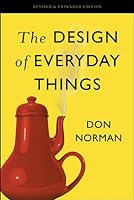
The Design of Everyday Things

Signifiers can be deliberate and intentional, such as the sign PUSH on a door, but they may also be accidental and unintentional, such as our use of the visible trail made by previous people walking through a field or over a snow-covered terrain to determine the best path.
Don Norman • The Design of Everyday Things
Many people find affordances difficult to understand because they are relationships, not properties.
Don Norman • The Design of Everyday Things
Discoverability results from appropriate application of five fundamental psychological concepts covered in the next few chapters: affordances, signifiers, constraints, mappings, and feedback.
Don Norman • The Design of Everyday Things
It is the duty of machines and those who design them to understand people. It is not our duty to understand the arbitrary, meaningless dictates of machines.
Don Norman • The Design of Everyday Things
Feedback—communicating the results of an action—is a well-known concept from the science of control and information theory.
Don Norman • The Design of Everyday Things
To summarize: • Affordances are the possible interactions between people and the environment. Some affordances are perceivable, others are not. • Perceived affordances often act as signifiers, but they can be ambiguous. • Signifiers signal things, in particular what actions are possible and how they should be done. Signifiers must be perceivable, e
... See moreDon Norman • The Design of Everyday Things
But as soon as there is a problem or a misunderstanding, the problems arise.
Don Norman • The Design of Everyday Things
There we have it. Seven stages of action: one for goals, three for execution, and three for evaluation (Figure 2.2). 1. Goal (form the goal) 2. Plan (the action) 3. Specify (an action sequence) 4. Perform (the action sequence) 5. Perceive (the state of the world) 6. Interpret (the perception) 7. Compare (the outcome with the goal) The seven-stage a
... See moreDon Norman • The Design of Everyday Things
An affordance is a relationship between the properties of an object and the capabilities of the agent that determine just how the object could possibly be used.